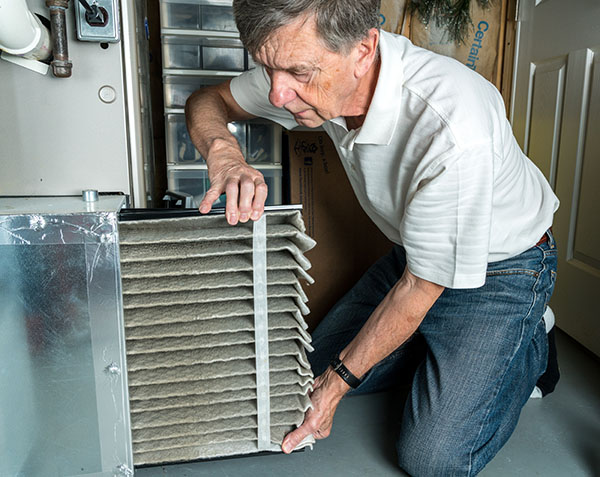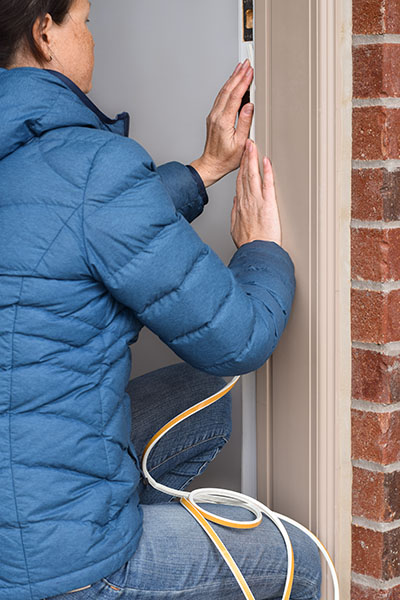 Conserve Energy and Save Money
Conserve Energy and Save Money
The average Ohio household spends over $2,000 a year on electricity and natural gas or other heating sources. In this fact sheet, the Office of the Ohio Consumers’ Counsel (OCC) provides energy-saving tips that can reduce your home’s energy costs. From easy, no-cost improvements to long term energy efficiency projects, these tips can help lower your energy costs by as much as 30 percent.
Living/Family Room
Simple Savings
- Minimize fireplace use. Make sure the damper is closed unless a fire is burning. If the fireplace is never used, plug and seal the chimney flue.
- Window coverings like drapes help better regulate home temperatures. In the winter, they can be used to reduce chills around windows. In the summer, they can be used to block light and reduce heat in the middle of the day.
- Move heat generating items, like a TV, away from the thermostat. Its sensor may be able to detect the heat from them making it harder to maintain comfortable temperatures in the home.
- Ceiling fans help efficiently circulate air. In the summer, run the fan counter-clockwise to force cool air down. In the winter, run the fan clockwise to pull cool air up and draw warm air down. Box fans also are a good option to move conditioned air. By circulating air, you can adjust the thermostat five degrees making it more comfortable.
Small Investment
- Consider a programmable thermostat. A properly set programmable thermostat can save homeowners as much as 10 percent per year according to the Department of Energy. Learn more about these thermostats at www.energy.gov/energysaver/programmable-thermostats.
Kitchen
Simple Savings
- When possible, use the microwave rather than the oven to heat small portions of food.
- When baking, keep preheating time to a minimum. Limit the number of times you open the oven door since heat is lost with each opening.
- Match the size of pots and pans to the heating element and cover with lids to retain heat and reduce cooking time.
- Keep your refrigerator or freezer away from direct sunlight or warm air (i.e. range, dishwasher, heating ducts, etc.) so that the appliance doesn’t have to use more energy to remain cold.
- Keep your fridge and freezer doors closed whenever possible. Keep the coils clean. Dirty coils decrease energy efficiency for cooling. And be sure to check the door seals are tight.
Long-term Energy Planning
- When replacing appliances, Energy Star provides information on annual energy usage, price, size, expected water use (gallons/cycle) and more at www.energystar.gov.
Bathroom
Simple Savings
- During the winter, allow warm steamy air to circulate into the rest of the house. Humidity in the air can help you feel warmer. Vent it out in the summer.
- Use bathroom ventilation fans sparingly. They can temporarily help remove humidity during and after a bath or shower. But overuse wastes energy by pulling heated or cooled air outside.
- Towel dry hair thoroughly before using an electric hair dryer.
- Find more tips on the OCC’s Guide to Water Conservation fact sheet.
Long-term Energy Planning
- Consider installing WaterSense certified water-efficient showerheads and faucet aerators to reduce how much hot water is used. WaterSense is the U.S. Environmental Protection Agency’s label for water-efficient products. Learn more at www.epa.gov/watersense.
Bedroom
Simple Savings
- Close closet doors to prevent heating and cooling unnecessary space.
- Unplug mobile devices when they are fully charged—do not charge overnight.
Small Investment
- Consider using seasonal bedding and alternate bedding types to reduce the need for cooling or heating the bedroom unnecessarily.
Attic/Basement/Utility Room
Simple Savings
- Only run the washing machine with full loads.
- Wash as many loads as possible using cold or warm water, instead of hot water.
- Do not overfill the dryer for air to efficiently circulate. Keep the filter clean and ensure air can pass through it by running it under water. Clean if necessary to improve air flow.
- Replace or clean the furnace filter as recommended by the system’s manufacturer.
- Set water heater temperature at 120 degrees to reduce heat loss.
- Wrap older water heaters with an inexpensive insulation blanket to save up to16 percent on water heating costs.
- Maintain your water heater according to your owner’s manual’s recommendations to extend its life and maximize efficiency.
- Insulate water pipes to reduce heat loss. Foam pipe sleeves can help raise water temperature two - four degrees allowing for a lower water heater temperature.
Small Investment
- Have a professional inspect and tune up your air conditioner and furnace once a year.
- Control moisture in basements and crawl spaces. Vapor barriers, such as waterproof paint on walls and heavy plastic sheeting on crawl space floors, can help control moisture.
- Install a radiant barrier in the attic to help reduce summer heat gain and winter heat loss. Consult a professional to determine if a radiant barrier would be an effective home option.
Long-term Energy Planning
- Add insulation to your attic and around air ducts in unheated spaces. Consult a professional for major insulation projects. The U.S. Department of Energy recommends insulation thickness of at least R38 for attics, R13 for wall cavities and R25 for floors in Ohio.
- When replacing a major appliance (i.e. refrigerator, water heater, washer, dryer, etc.) consider purchasing an Energy Star model. Energy Star products use less energy and can reduce energy bills.
- When replacing a furnace, look for models that have annual fuel efficiency ratings of 85 and 90 percent or greater. These models are up to 15 percent more efficient. Properly size the furnace for the space that needs to be heated. A unit that is too big costs more upfront and increases heating costs because it is likely to turn on and off more frequently.
All Rooms

Simple Savings
- Maintain your home’s relative humidity (RH) levels between 30-50 percent year-round to help you feel more comfortable and reduce the need to raise or lower your thermostat.
- Insulation kits can act as temporary storm windows for older windows.
- Always turn off lights when you are not using them. Consider installing timers or sensors to reduce the amount of time your lights are on.
- Eliminate vampire power. Many electronics consume energy even when turned off. Unplug them when not in use. Power strips allow consumers to turn selected devices completely off. Smart power strip can automatically power off electronics. For more information, see the OCC’s fact sheet called What’s Draining your Energy? Vampire Power.
- Ensure all windows are closed before turning on heat or air conditioning.
- Unblock all registers, air supplies, and return vents.
- Keep registers, baseboard heaters, and radiators clean.
- Insulate light switches and electrical outlets to keep air from leaking around them.
Small Investment
- Install storm windows to existing pane windows. This is a cheaper, yet effective, option to replacing windows.
- Apply low-emissivity window film to save 10–30 percent on heating and cooling costs. These are best applied to south, east, and west-facing windows.
- Consider using light paint colors on walls and ceilings, and light-colored flooring to help reduce the amount of light you need.
- Fix window and door air leaks with weather stripping and caulk to reduce heat or cooling loss.
Outdoors
Simple Savings
- Put outdoor lighting on timers or motion detectors. Outdoor lights are often on the longest of any household lighting.
Small Investments
- Consider solar lighting for your outdoor lighting. Charged during the day, the solar light’s sensor turns them on at night. The rechargeable battery involved can provide light for eight to 10 hours with no added cost.
Long-term Energy Planning
- If making improvements to the shell of a home (i.e. shingles, siding) consider materials that are light in color to help reflect heat away. Light-colored shingles can save on annual cooling costs.
- The garage is the largest un-insulated space of a home. If it is connected to the home, the furnace or air conditioner could be working harder than need be to heat or cool living spaces. Replacing weather stripping and insulating the garage door can help increase efficiency.
More Tips
More cost savings tips are available on OCC’s Summer Cooling Tips, Saving Energy During the Holidays, How to Shop for Lightbulbs, and Guide to Water Conservation fact sheets. For even more tips visit the U.S. Department of Energy’s websites at www.energy.gov and www.energystar.gov.
To download: Click the folder with a down arrow icon. To print: Click the printer icon in the top right of the display.
If you need multiple copies for an organization or group, please contact a member of our outreach team.

